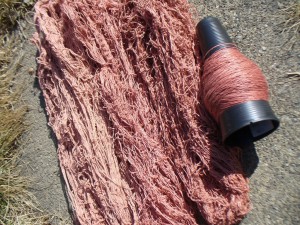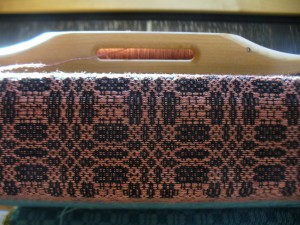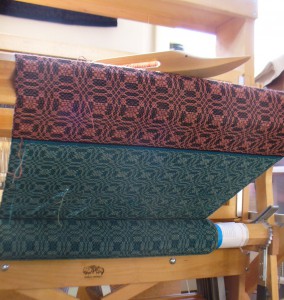After a leisurely process of heating, soaking, and delayed rinse, the first four skeins of madder-dyed yarns are done. Here they are outside today, a bright and sunny day.
 I’ve done four dyebaths so far. The photo above shows successive dyebaths moving from right to left. The yarn on the cone is from the first dyebath. The yarns in the first three dyebaths were 20/2 linen and the fourth was 22/2 cottolin. The linen yarns were mordanted with alum acetate, and the cottolin was mordanted with alum acetate plus tannin. The weight of goods in each dyebath was about 2 ounces.
I’ve done four dyebaths so far. The photo above shows successive dyebaths moving from right to left. The yarn on the cone is from the first dyebath. The yarns in the first three dyebaths were 20/2 linen and the fourth was 22/2 cottolin. The linen yarns were mordanted with alum acetate, and the cottolin was mordanted with alum acetate plus tannin. The weight of goods in each dyebath was about 2 ounces.
For the last couple exhaust baths I am preparing 10/2 cotton (bleached) because that’s what I have on hand at the moment. After some disappointing results with my last two umbilicate dyebaths, and out of a general desire to achieve greater depth and brightness of colors on cellulose fibers, I am going to try some new procedures. I’m especially frustrated with cotton at the moment, and for help I am turning to Jim Liles’ book The Art and Craft of Natural Dyeing: Traditional Recipes for Modern Use. In his instructions for scouring cotton, Liles writes, “… simmer or boil for an absolute minimum of 2 hours. Three or 4 hours is better in some cases, and in the old days cotton was sometimes scoured at the boil for 8 hours. Cotton is full of wax, pectic substances, and oil, all of which must be removed.” This is much longer than I’ve ever scoured before.
So, I boiled the skeins for two hours with anionic cationic scour 12/17/2023 Correction! (from Earthues) and soda ash. Then I rinsed them three times, and mordanted with alum acetate at 5% weight of the goods at 100 degrees for one hour, let the yarns steep in the mordant for a couple days, dried them, and am now re-mordanting in the same mordant bath. This procedure is a combination of my usual cellulose treatments (based on recommendations from Earthues) and recommendations from Jim Liles.
Double-mordanting with a period of drying in between is a new experiment for me. Liles gives instructions for making your own aluminum acetate, and writes that you should wait until the acetic acid smell has dissipated before proceeding with dyeing. Since I am using alum acetate that I did not have to make myself, I didn’t detect any acetic acid smell after mordanting the first time, so I went ahead with the second mordant bath after just drying the skeins for a day.
Next will come the “fixing solution” Liles recommends. To remove unbonded mordant, he recommends soaking with a solution of calcium carbonate or sodium phosphate for 30 minutes, then rinsing with water. I’m not sure from the book whether I can just use calcium carbonate, or whether it has to be soaked with cattle or sheep dung. It seems to me that if I have the calcium carbonate, I don’t need the dung (since that seems to be a source of sodium and calcium phosphate), but maybe it helps.
Since I am already pretty far along with this madder project, I’m not planning to make any changes to my usual dyeing, drying, or rinsing steps with the last exhaust baths this time around.
However, for my next madder project I will try one of Liles’ recipes for madder red. Reading through his recipes has been very eye-opening and I am fascinated by, and kind of surprised by, many of the things he writes about. For example, instead of just rinsing the madder-dyed goods, he describes a process where the dyed material is simmered or boiled with soap. This is supposed to make the color brighter and more clear. I watch the temperature very carefully while the roots are extracting and the yarn is in the dyebath to make sure it *doesn’t* boil or even simmer. It never occurred to me that high heat later in the process could be beneficial. Also, he writes that the dyebath ought to be acidic when dyeing cotton or linen with madder. Oops. Did you see my pH comments in the last post? Clearly I had the wrong idea about what that calcium carbonate was for. In fact, he writes that making the dyebath alkaline will produce a bluish-purple. Well, I didn’t get anything like purple this time with my alkaline dyebath, but maybe I can…. So many things to try.
Here’s the madder-dyed linen yarn getting woven into cloth with black 20/2 cotton tabby weft.
This shot is from underneath the breastbeam to show the cloth winding onto the cloth beam. I really like these colors together. The blue-green is woad overdyed with weld.


